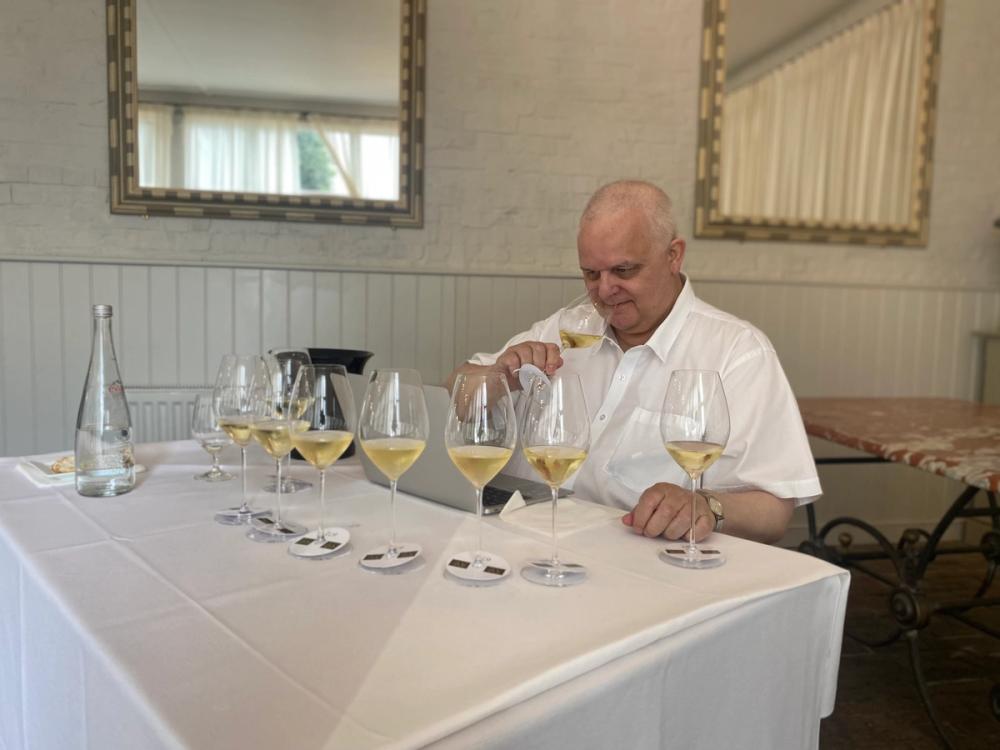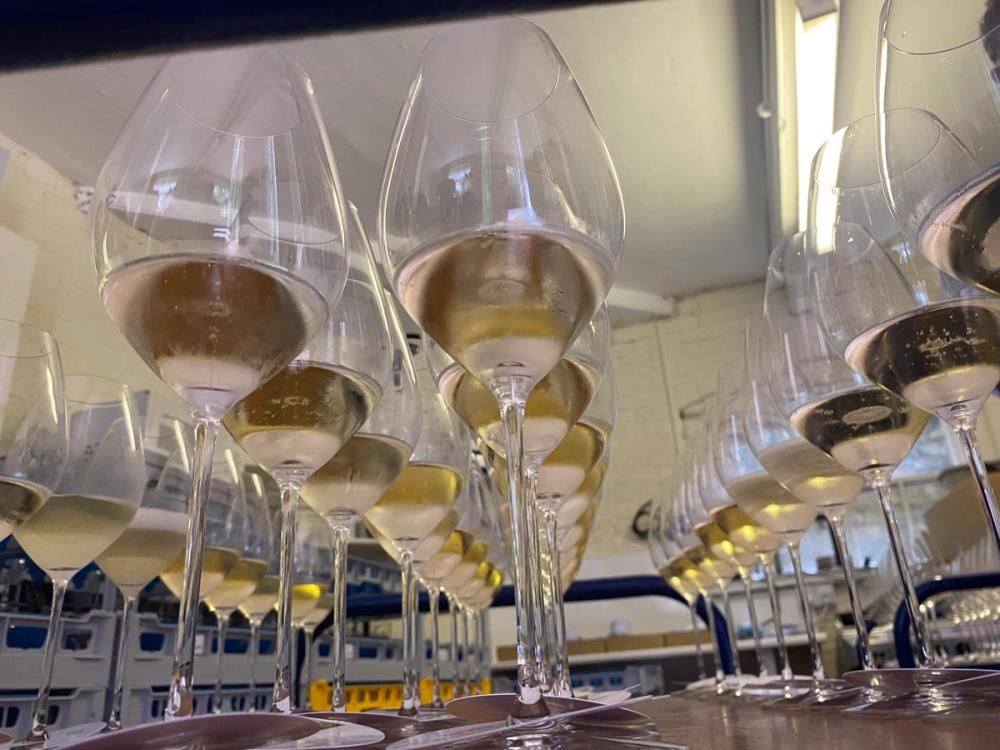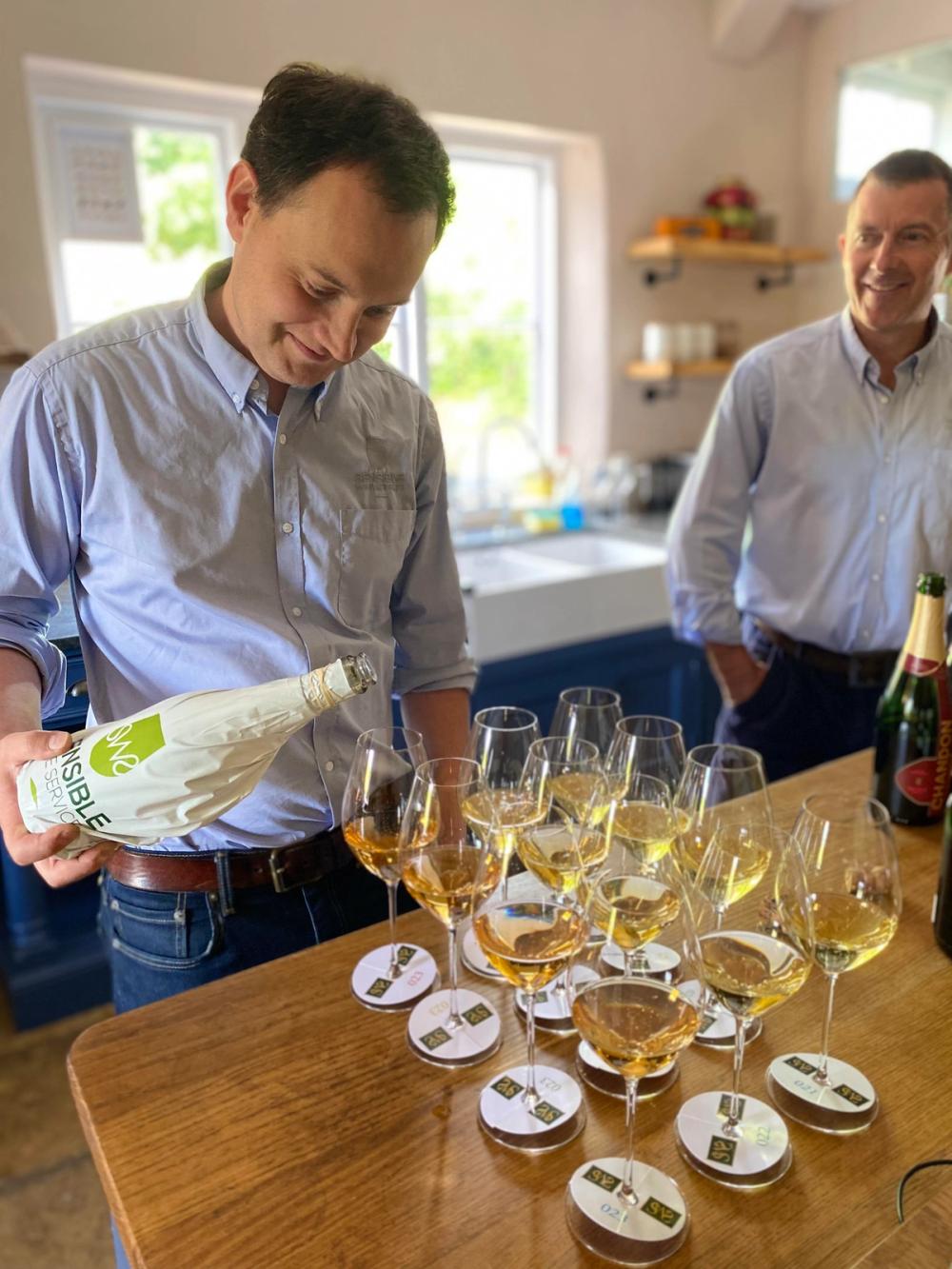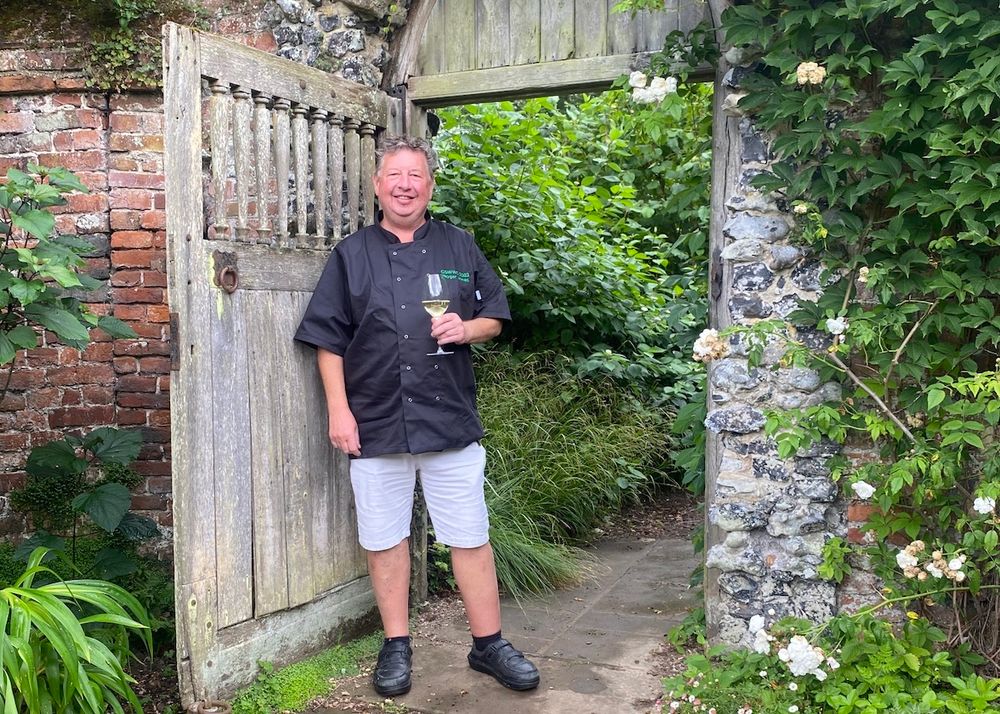You are now 10 years old as a competition – how do you think it has evolved in that time?
The first year of the Champagne & Sparkling Wine World Championships (CSWWC) was 2014, exactly 10 years ago. It was and still is the only wine competition in the world that has the same judges to evaluate every wine for consistency and where all the judges are renowned sparkling wine experts.
Individuals with a different taste perspective may legitimately disagree with the judgements of others, of course, but what cannot be disputed is the unprecedented experience deployed by the CSWWC and the unique consistency this brings to bear on its judgements, not just from one wine to the next, but also from one year to the next.
This consistency, the checks and balances we have introduced, and the flexibility of a niche competition to make changes on the fly are key to how this competition has evolved over the last 10 years.

Tom Stevenson has worked tirelessly to make the CSWWC awards as rigorous and highly respected as possible
Initially, I took the most favourable experiences from my 7-year term as double-chair at the DWWA, added multiple aspects of the Australian Wine Show System, and totally ignored the OIV International Code to create an ideal framework upon which to build the best practices of a wine competition by continuously adding and tweaking improvements.
Much of it is as easy as ABC, such ensuring that all judging is truly blind and that all medals are assessed strictly by provenance and style. We serve wines ready-poured in numbered Riedel Veritas Champagne glasses to ensure blind means blind, with no bottles covered in bags providing clues.
One of the very first measures I introduced was an empty numbered glass factor for any missing wines. How many tastings had I been to and be told “There is no number X because it hasn’t turned up” only to witness tasters muttering to themselves as they try to rescue their notes when they realise they had not noticed the missing wine half an hour later and all their notes were out of order?
Another early improvement was a systematic bottle-variation check for every wine that scores Bronze or below (Silver or below for Deluxe Champagnes). A fresh bottle of the same wine is opened and compared side-by-side with the bottle that was judged by our quality control taster in a separate room, and any deemed to be better are slipped back into the judging without any indication of their actual wine number. This prevents anyone from referring back to their notes and possibly being prejudicial in their approach to the fresh sample.
Not that anyone would. I would like to think we are more professional than that. But if we are going to have checks and balances, it is important that they are robust. I don’t think that anyone who has ever judged at a blind tasting has not at some time asked themselves “Did I really give such a low score for that wine?” and been left wondering whether it was their fault or the wine’s fault.
Well, now we know and we no longer have sleepless nights. All wines are given every chance and they stand or fall on their own merits. We are absolutely ruthless in opening second and third bottles during the judging. We do not even discuss it: if any judge has the slightest doubt about the condition of any bottle, he or she calls for another, but it is always possible that a wine has been scalped and with no obvious fault could simply score low because it lacks fruit. That has not been a worry at the CSWWC for the last nine years.

Every bottle and every glass is meticulously assessed before being tasted and judged
Sometimes our ideals conflict with the reality of the situation and we need to seek a practical solution. For example, we campaign against the use of clear-glass bottles, but we must do everything to preserve the quality of the wine inside any such bottles. Clear-glass is responsible for light-strike, the second-most common fault we encounter. Although it is the easiest potential problem to resolve if they stopped using it, many producers place a higher priority on presentation than on quality control, and while that continues, it will remain a clear and present danger.
The problem from any competition’s point of view is that entry bottles stand around on trestle-tables, shelves or even the floor for hours on end as they are catalogued and placed into their relevant flights. Light-strike aromas, however, start to build after just 60 minutes exposure.
It took us one year to recognise this and from year two we have double-bagged all clear-glass bottles in thick black plastic the instant they are extracted from the boxes they are delivered in. If a producer sends us wines that are already light-struck, that is their fault, but if they send us a clean and pure wine and we taint it through exposure to light, that is reprehensible.
We have been banging on about this for years, expecting others to follow suit on what is an easy, cheap, no-brainer solution for any competition that cares about fairness. The IWSC followed suit in 2023, which I applaud, but I know of no other major completion that has adopted any form of clear-glass protection.
The ability to adapt and refine processes on the fly is one of the primary strengths of a niche wine competition like CSWWC. Five years ago, Tony Jordan suggested that we taste Brut Nature randomly mixed in the Brut category. It is merely a subdivision of Brut anyway, so there is no technical reason why we should not taste Brut Nature, Extra Brut and Brut randomly mixed.
The first advantage is that we are not pre-warned of a Brut Nature wine, so everything is tasted on balance, with no temptation to think “this is good for a Brut Nature”.
The second advantage is a product of the first and that is the superiority of the result. If a Brut Nature can stand up to and occasionally stand out from medal-winning Brut wines, then it has demonstrated exceptional quality. It probably has a higher level of ripeness without compromising the acidity, length and focus of a great classic sparkling wine, but whatever the reason, a Brut Nature that wins a Gold medal at the CSWWC will always be a shining example of its type.

The Sensible Wine Services team are on hand for the full two weeks of judging
We are constantly tweaking the process. Just a month ago, in the middle of CSWWC 2024, I changed how we conduct taste-offs. We have taste-offs for lots of reasons, from totally objective Best in Class to increasingly more subjective Trophies where the competing wines are often a choice between apples and pears. Whenever there are a lot of wines to rank in order of preference, our modus operandi was always to reduce that number to a more workable one by first knocking out those we agree stand the least chance.
This year, however, we had a lot of Best in Class taste-offs that were twos and threes. After each of us commented on how easy it was, I decided to turn our modus operandi on its head and split every large taste-off into a series of semi-finals, so that a taste-off of nine wines would be three taste-offs of three wines, followed by a final of the three semi-final winners. No system is perfect, but it is better and we will run with it until and if something else should be tried.
What is the scale of the awards now compared to year one?
We started with 651 entries in 2014 and averaged 650 up to 2018, when the number of entries jumped to 830, then it increased to just over 1000 in 2019. Since then, it has averaged at about 1000 a year.
Even when we averaged a similar number of entries, the number of participating wineries always increased. This was an organic phenomenon as new entrants began to realise that we do not award Bronze medals.
Additionally, new entrants soon realise that we consider premox aromas in the world’s most famous reductive wine to be a fault, thus oxidative sparkling wines are not worth entering. These two factors organically reduce the number of wines submitted by previous entrants, effectively balancing the increasing number of wines coming from new entrants.
It might restrict the profitability of the CSWWC, but life is too short to wade through such disappointing wines, and the more medal-rich our flights become, the happier we are.
We have also seen an increase of countries and regions since the competition began. Last year we had 40 different regions from around the world enter their wines with the medal table also reflecting this with 170 Gold medals awarded last year.
What are you most proud of achieving in that time?

The judging for the CSWWC awards sees the full judging and support team stay for two weeks together at the very grand and historic Goodnestone Park in Kent
I am very proud of the professionalism and camaraderie of the team we have built. It takes almost two weeks to complete the judging process because each judge has to taste and assess every wine entered and we must give due time and consideration to each one.
As we have to live in each other’s pockets 24/7 for the duration, I have always tried to make it a bit of holiday in the downtime. They work very hard when we are judging and in preparation for judging, so they should be able to relax when off duty, so we all live in at the competition’s home, Goodnestone Park, in Kent.
That includes Donald and James of Sensible Wine Services, who handle the logistics and servicing of the competition, and are just as much a part of the CSWWC family as anyone. We have sole use of Goodnestone Park (pronounced Gunston Park), a magnificent 18th century Palladian mansion where Jane Austen often attended dinners and balls. It was the inspiration for Darcy's Pemberley in Pride and Prejudice. Austen’s brother Edward married into the FitzWalter family (the current owner is Julian Plumptre, the 22nd Baron FitzWalter).

Former Michelin star chef Roger Jones is behind all the courses and meals prepared during the two weeks with dishes created to work with the judges palates
When the team is not working, or sleeping in its luxurious bedrooms, or enjoying gourmand breakfast, lunch or dinner prepared former Michelin chef and CSWWC Ambassador Roger Jones, they may be found writing in the Jane Austen Room surrounded by first editions for inspiration, relaxing in one of the other sumptuous reception rooms, sipping a refreshing cordial on the terrace or drinking a single-estate espresso provided by our partner Difference Coffee, strolling through the walled gardens or wandering around the 2,000 acre estate.
Yes, we are all thoroughly pampered. Thank goodness that as a niche competition, rather than a corporate moneymaking machine, I don’t have to justify the expenditure, but I am proud the CSWWC places a much higher priority on team-spirit than profit margin. A happy team produces better results and it is those results I am ultimately most proud of.

Champagne might still be the most famous sparkling wine in the world, but only by tasting and comparing them every year can we find which Champagnes justify their reputation as the very best on a consistent basis and, intriguingly, which Champagnes you might not suspect are great this year.
I’m also proud of shining the spotlight on the amazing achievement of truly world class sparkling wines produced by the likes of Milazzo in Sicily, Kettmeir in Alto Adige, Carassia in Romania, and Midalidare in Bulgaria.
We have witnessed a new wave of artisanal Lambrusco producers who are crafting quality for partnering at the table, and we have taken Prosecco seriously. Until I wrote a Prosecco piece for Decanter magazine in 2007, you would have been hard put to find a wine writer of any repute writing a single word about Prosecco in the UK or USA.
The amount of snobbery and prejudice is unbelievable, but the truth is that most Prosecco drinkers do not like the taste of yeast-aged sparkling wine and just because most wine writers do, does not mean that an entire category of wine drinkers should be disenfranchised when it comes to looking for the best. And that is all we did, look for the best, and look at its success today.
Twenty years ago Prosecco could not be found in a Michelin starred restaurant: now it is difficult to dine at a Michelin starred restaurant that does not list it. They still have problems and the biggest is the lack of brand awareness amongst its most regular consumers, but the CSWWC is working on that by highlighting the best every year, and I am proud of that.
What have been the biggest lessons you have learnt in running a competition?
All the big stuff, such as clear communication, transparency, and fairness we understood before we started the first day of the first year of judging, and as already explained, we have enjoyed the rewards of being as adaptable and flexible as only a niche competition could be.
Personally, the biggest lesson for me has been not to micro-manage. The secret of good management is the art of delegation: find people who can do the job and let them get on with it.
What are your outstanding ambitions for the awards?
Our original ambition has already been achieved and that is to provide a global, not simply single market, platform to promote world class sparkling wines for the consumer and a constant, consistent sounding board for entrants. This is important for entrants from established sparkling wine provenances, of course, but it is vital for emerging regions where there are no yardsticks or, at most, too few against which to compare and calculate progress.

The CSWWC awards has become the official night for the Champagne and sparkling wine worlds to come together
I picked this up in the mid-to-late 1980s, when visiting emerging wine regions; not specifically emerging sparkling wine region, but emerging wine regions as a whole. They had nothing to compare their wines against and I was often the very first internationally known wine journalist to visit their neck of the woods, consequently they would be eager to know how I felt their wines rated on the world stage. Many times they did not rate very well, but those producers who were serious always wanted to know why their wines fell short, so they could adapt and improve. I have tried to carry that process through to the CSWWC.
For those who don’t know the judging process, can you explain how the judging has evolved and improved to give the best possible results?
We started out on the basic premise that no one goes into a shop to ask for a Bronze medal wine. We therefore set our bar at Silver, whereas most competitions award Bronze and some even award Commended or something similar below Bronze. Others have added another layer on top, such as Double Gold or Platinum, which merely devalues the true worth of a Gold medal.
We judge conventionally (Gold, Silver, Bronze, No Award, Possibly Faulty and Definitely Faulty), but award only Gold & Silver or just Gold for Deluxe Champagne.
The reason we recognise only Gold for Deluxe Champagnes is because as a category they are so expensive they surely must be Gold by definition, shouldn’t they? If they are not, they fail to make the cut at the CSWWC. Silver for me and for the other judges is an exciting wine that is well worth searching out, but a super-expensive Deluxe Champagne must have additional polish and perfection.
All wines are tasted blind. We have to have a yardstick of some sort, so we know the general origin, such as Champagne or Franciacorta, the style (whether it is a blend, blanc de blancs, rosé etc) and sweetness category, like brut, demi-sec etc (but never anything as precise as the residual sugar) and we never see a bottle, covered or otherwise as there are far too many clues in the shape, weight and in a centimetre of bottle neck protruding from the cover. Judging is not a guessing game. Once you start down that path madness lies and the integrity and impartiality of judging is lost.

Tom Stevenson with Essi Avellan MW and Georgus Markus
We have a panel of three judges because that is the optimum number for efficiency and accuracy. Not three judges and a chair with a casting vote, but three judges including the chair, who has no casting vote. I am the chair; Essi Avellan MW and George Markus are the two other judges, and between us we have racked up more experience tasting and evaluating Champagne and other sparkling wine than anyone else in the world. That’s notbragging, it’s a simple statement of fact.
I alone have been doing this for 43 years and no one else comes close to matching that. It is the combined knowledge and experience of all three judges evaluating each and every wine entered that makes winning a medal at the CSWWC the ultimate accolade. Some producers no longer enter the competition when they do not win the Golds and Silvers they are used to winning elsewhere, while others who initially had the same experience have taken note of our criticisms (provided confidentially through their online account) and now do win medals.
While three judges evaluating every wine is ideal, it does leave us exposed should one of us fall ill or be otherwise indisposed, which is where our Reserve Judge comes in. Under such circumstances, we need not only a highly experienced sparkling wine taster to cover us, however temporarily it might be, but also a person who is in the zone at any unpredictable moment, and that can only be achieved if the Reserve Judge tastes each flight with us.
That person for the last six years has been Simon Stockton, who has been mentored by Essi, George and me while tasting and discussing thousands of Champagnes and sparkling wines under blind, competitive conditions.
When Simon became the Reserve Judge, his previous role of Competition Steward was taken over by Harriet Wright. It was an emergency decision taken when our own mentor and good friend Dr Tony Jordan passed away suddenly and unexpectedly.
Moving Simon to Reserve Judge was obvious, but finding someone to “run” the judging panel, to act as the conduit between us and the wines, and liaise with Donald of SWS over the constantly evolving admin of the competition once it has been set into motion requires a combination of tact, friendliness and firmness.
Within 24 hours of having to make a decision, I took on Harriet on the basis of a personal recommendation of Karl Franz, who was fulfilling Donald’s role at the time. I did not meet up with her because, simply, there was no time, so I was half expecting to drop her after the 2019 competition and spend the next 12 months searching for someone more suitable. Well, six competitions later and Harriet is still at the heart of the CSWWC family. She’s brilliant!
Judging criteria

Judging medals is the foundation of any wine competition. Get that wrong and everything that follows is pure fiction. The methodology we follow is what I describe as Anglo-Aussie rules, where we judge in silence, but discuss the wines if necessary after we have read out our score to the Competition Steward. This is the complete antitheses of OIV rules. According to Clause 1.1 of Article 9 of OIV competition rules, “jurors shall remain silent and make no gestures or facial expressions indicative of their impressions during the wine tasting and rating” and it is the last two words that make a mockery of that system because that is precisely where discussion should prevail.
The order of play in the competition is:
Medal judging: exclusively style by style on a region by region basis in numbered glasses.
Best in Class: the best non-vintage Gold and best vintage Gold of each regional style (numbers not revealed).
Best in Class to go forward to Trophy by Style taste-offs: best non-vintage Gold vs best vintage Gold of each regional style (A or B, randomised).
Regional Trophies: all Best in Class compete for best in region (numbers not revealed, all apples & pears from now on).
National Trophies: all Regional Trophies (or Best in Class or Gold medals, if none) compete for best in country.
Trophies by Style: all winners of Best in Class non-vintage vs vintage taste-offs compete for trophies such as Best Blanc de Blancs, Best Rosé etc.
Supreme Champion: all National Trophy winners compete.
* In part two Tom Stevenson shares his thoughts on the future of the Champagne and sparkling wine sectors.
































